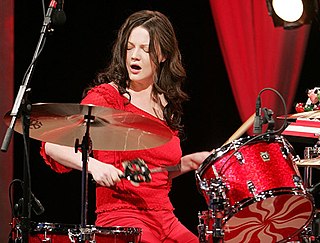Top Qs
Timeline
Chat
Perspective
In the Cold, Cold Night
2003 song by the White Stripes From Wikipedia, the free encyclopedia
Remove ads
"In the Cold, Cold Night" is a song by American rock duo the White Stripes from their fourth studio album, Elephant (2003). The fifth track on Elephant, it was written and produced by Jack White specifically for Meg White to sing, marking her first time performing as the band's lead vocalist. The song was also composed by the duo.
Musically, "In the Cold, Cold Night" features a minimal soundscape and lyrics about a woman awaiting her lover's return. The song was praised by music critics for the composition and vocals, even though it was not released as a single. It is considered a highlight of the White Stripes discography due to Meg's rare lead singing position.
Remove ads
Recording
The White Stripes made their recording debut in 1998, and Jack White was established as the duo's guitarist and lead vocalist and Meg White their drummer.[1] She only performed background vocals for the band's second and third studio albums, De Stijl and White Blood Cells respectively,[2] and shared vocal duties with Jack on the Loretta Lynn cover "Rated X" which features as the B-side to their 2001 single "Hotel Yorba".[3] After the band's international breakthrough with White Blood Cells, they began to create material for their fourth studio album, Elephant.[4]
"In the Cold, Cold Night" was one of eleven songs recorded through April and May 2002 at Toe Rag Studios in Hackney, London.[5] It is the first time Meg recorded leading vocals on any work of the band to that point; to gain confidence in her singing abilities, she sang more during their live performances and covered The Velvet Underground's "After Hours".[4] Meg would sing lead once more on "Passive Manipulation" in their follow-up album Get Behind Me Satan (2005),[6] and deliver a spoken-word performance on the bagpipe-heavy track "St. Andrew (This Battle Is in the Air)" in Icky Thump (2007).[7]
Remove ads
Composition
"In the Cold, Cold Night" is an alternative rock, blues rock, and garage rock song.[8] Unlike the band's prior work, the song does not have any percussion and features a minimalist soundscape of guitars and bass pedals of a Hammond organ.[9] The song is written in the key of D minor with a tempo of 112 beats per minute, and Meg's voice ranges from soprano to mezzo-soprano.[10]
Jack wrote "In the Cold, Cold Night" specifically for Meg to sing.[4] Though its lyrics have been interpreted ambiguously, the song is about a young—and possibly inexperienced—woman pleading for her lover to return.[11] Critics and audiences have noted its contrast to the rest of the band's songs for both Meg's leading position and its cryptic atmosphere.[12]
Remove ads
Release
The song was never released as a standalone single, but it was a staple of the White Stripes' live performances and was frequently performed by the band from 2003 until their final performances in late 2007.[13] Notable performances of "In the Cold, Cold Night" include those at the Aragon Ballroom in 2003,[14] Madison Square Garden in 2007,[15] and during their 2007 Summer Tour in Canada featured in the documentary Under Great White Northern Lights (2009).[16] A visualizer for the song was created for Elephant's 20th anniversary in 2023.[17]
Reception
Summarize
Perspective

"In the Cold, Cold Night" has received positive reviews from music critics, both at the time and retrospectively. AllMusic's Tom Maginnis likened the song to Little Willie John's "Fever", praising the atmosphere and Meg's vocals.[12] Matt Harvey of BBC said that "Meg speaks and (unlike her drumming) comes across all fey and, well, sort of pre-Raphaelite in a down-town Motor City kind of way. [...] it's all so divinely confident, so sexy."[18] Alexis Petridis of The Guardian called her vocals "childlike", praising its "stark, unaffected quality" and its "radical departure" from the band's usual sound.[19] Petridis later called it "her finest moment not as the White Stripes' drummer, but their vocalist".[20] Brent DiCrescenzo likened her voice to "a coy Mo Tucker or Georgia Hubley–more so than take-no-sass Patsy Cline or Dusty in Memphis."[21] Ron Hart of Spin deemed her singing "sweet and tender", and Cat Clyde later wrote for Spin: "I loved that Meg's voice was timid. It felt so real. ... I still feel today it's such a perfect recording."[22]
Eric Alper believed the song allowed Meg to prove her worth amidst contemporary criticisms regarding her role in the band. He described her vocals as "soft, haunting" and the track as "a vulnerable moment that added emotional depth to the record."[23] Stephen Trageser of Nashville Scene believed the song has an "unsettling, ambiguous sentiment" with a "determined creepiness".[24] Staff at The Quietus wrote: "her (Meg's) clear-voiced invocations of flickering flame carnality exude a shy, eye-of-the-storm poise which contrasts beautifully with the high voltage drama that hallmarks the song's chart-topping parent album (Elephant)".[25] Tom Breihan of Stereogum believed Meg "brings a magnetic remoteness" and called it "beautifully weird".[26]
Remove ads
Personnel
Credits are adapted from the liner notes of Elephant.[27]
|
The White Stripes
|
Additional personnel
|
Cover versions
- In 2012, Tracey Thorn included a cover of the song on her Christmas album Tinsel and Lights.[28]
- In 2013, the song was covered by singer-songwriters Wanda Jackson and Shooter Jennings for the compilation Rockin' Legends Pay Tribute to Jack White.[24]
References
Wikiwand - on
Seamless Wikipedia browsing. On steroids.
Remove ads
